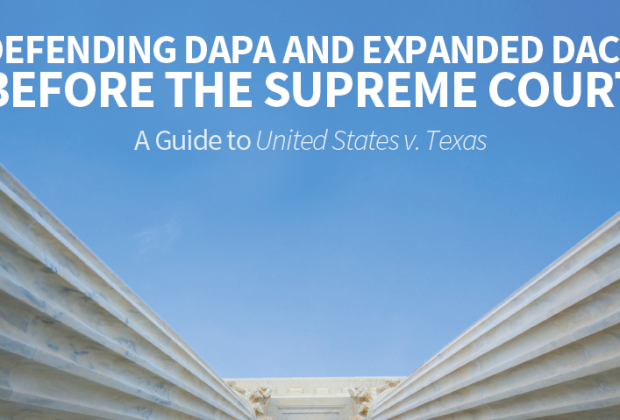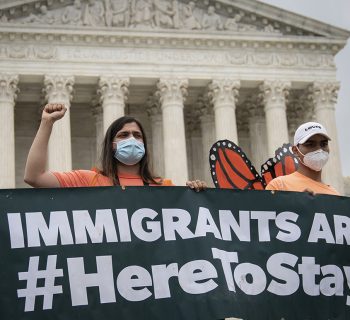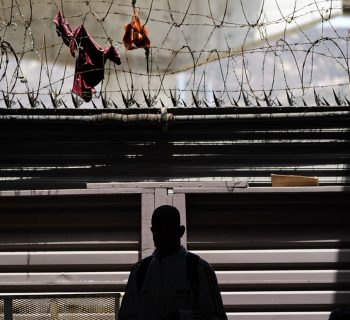By Miriam Feldblum, The Chronicle of Higher Education ~ April 15, 2016
In a case that could have profound implications for current and future college students, the Supreme Court will consider on Monday a challenge by Texas and 25 other states to the Obama administration’s 2014 creation of the Deferred Action for Parents of American Citizens and Lawful Permanent Residents program and to the expanded eligibility of the Deferred Action for Childhood Arrivals program, known respectively as the DAPA and DACA programs.
DAPA provides temporary work authorization and relief from deportation to as many as 3.6 million undocumented immigrants; the expanded DACA also would provide, if endorsed by the court, those protections to some 280,000 young adults who came to the United States as minors, adding to the 1.2 million already eligible in the existing program.
Higher-education institutions have a lot at stake as the Supreme Court hears arguments on Monday over two key programs created by the Obama administration.
Most colleges are paying little attention to the legal challenges to the programs. Only 13 of them, plus the University of California system — along with a handful of higher-education associations — joined the hundreds of organizations, business leaders, states, counties, and others that signed amicus briefs in favor of the programs. That’s too bad because it is crucial that we in higher education take a stand in support of them. Here’s why.
First, the children of undocumented-immigrant parents are significantly and adversely affected by their parents’ lack of work authorization and vulnerability to deportation. AMigration Policy Institute report has estimated that approximately four million children who are citizens or legal permanent residents are living with parents who are unauthorized. Over all, more than 10 million children, youths, and adults live in households with at least one DAPA-eligible person.
The report estimates that the ability to work legally would increase the average annual income of families with potential DAPA recipients by 10 percent. More to the point, the program would improve the educational prospects of their children. Currently, children of unauthorized-immigrant parents face higher barriers to use financial and other resources, are more likely to live in poverty, and are less likely to go to college.
Immigrant advocates and others have had to reassure U.S.-born children, fearful of filling out the federal financial-aid form that would reveal their parents’ status, that it is fine to do so. This daily stress affects the well-being of those who do make it to college, and students living in families torn apart by the deportation of a parent — or fears of a family life in limbo — can be found across college campuses.
As a dean of students, I hear of that fear directly from students. Indeed, in talking with some of the colleges that signed on to a brief submitted by Educators and Children’s Advocates, I heard them cite most often their desire to support their current undocumented students and others who could be most affected, even if the numbers on any one campus were relatively small.
Second, many individual colleges and all the major national higher-education associationshave supported increasing access to higher education by undocumented students. If the Supreme Court decides to permit the deferred-action programs to go forward, it will increase the enrollment of both DAPA- and DACA-eligible populations in higher education.
There are few national estimates of the number of undocumented-immigrant students in higher education. One recent study estimated that in states with concentrated immigrant populations, the number ranged from 1 percent to 2.5 percent of overall college enrollment, and otherwise below 1 percent; other research has suggested it’s approximately 2 percent of national enrollment, with students enrolled in both community colleges and four-year public and private institutions.
By way of comparison, a 2011-12 U.S. Department of Education survey showed that, among first-generation immigrant undergraduates (not including undocumented immigrants), 44 percent enrolled in community colleges and 36 percent in four-year public and private institutions.
This leads to a third point: The creation of the new DAPA status will significantly increase access to in-state tuition to undocumented immigrants. Already, in more than 20 states, legislative action or Board of Regents’ decisions have given resident undocumented students access to in-state tuition, and at least six states have included access to some form of financial assistance.
The advent of DACA has created new grounds to claim access to in-state tuition. In states as diverse as Massachusetts, Mississippi, Ohio, and Virginia, which have not passed any measures regarding access to in-state tuition, DACA recipients have been deemed eligible for in-state tuition.
Even in Alabama, Arizona, and Missouri, which have enacted legislation barring access to in-state tuition, DACA recipients have gained access.
A growing body of research shows that receiving deferred action as well as gaining access to in-state tuition substantially increases undocumented students’ college-matriculation rates and the likelihood of their continuing their education.
The fourth reason is connected to a core mission of higher education: It has long been a priority of higher-education leaders to tout the benefits of college and advanced education, yet some of the most forceful arguments in favor of DAPA and extended DACA have comefrom business and high-tech leaders.
A better-educated work force benefits local economies. Lack of work authorization as well as lack of ability to pursue higher education translates into missed opportunities to nurture talent for colleges and universities, lost wages for individuals and families, and less revenue for cities, states, and regions. Higher-education leaders should be making those arguments, too.
While undocumented-immigrant populations are considerably larger in states such as California, Texas, and New York, they are reflected across the country. Likewise, though most eligible DAPA recipients are found in California, with a little over one million, followed by Texas and New York, there are more than 100,000 potential recipients in Florida, Illinois, New Jersey, Georgia, and North Carolina. The DAPA- and DACA-eligible populations, along with their U.S.-born family members, live in communities across the country.
The final point concerns our future. With the fate of DAPA before the Supreme Court, the 2016 presidential campaign underway, and continuing state-level efforts, now is the time for colleges and universities to lay the groundwork for a more active stand on immigration reform. We must not miss this vital opportunity.
Miriam Feldblum is vice president for student affairs, dean of students, and a professor of politics at Pomona College. She is a visiting fellow at the Migration Policy Institute.







